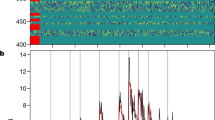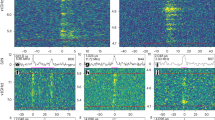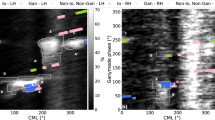Abstract
THE correlation between the occurrence of the Jupiter radio bursts and the position of the satellite Io has been reported to exist mainly for wave frequencies between 20 MHz and 40 MHz (ref. 1). Below about 17 MHz little correlation has been observed2. Jupiter's radio bursts may be roughly divided into two classes: the long, or L, bursts with a single frequency duration of seconds and the short, or S, bursts with a single frequency duration of 1–10 ms. Previous investigations of the Io effect have not distinguished between these two types of bursts. Here we describe a separate study on S bursts in which their occurrence probability is found to be strongly correlated with the position of Io above and below 17 MHz. In order to detect this result, spectrum analysers capable of separating out the S bursts from other jovian emission over a large frequency range had to be used3.
This is a preview of subscription content, access via your institution
Access options
Subscribe to this journal
Receive 51 print issues and online access
$199.00 per year
only $3.90 per issue
Buy this article
- Purchase on Springer Link
- Instant access to full article PDF
Prices may be subject to local taxes which are calculated during checkout
Similar content being viewed by others
References
Bigg, E. K. Nature 203, 1,008–1,010 (1964).
Duncan, R. A. Planet. Space Sci. 14, 173–176 (1966).
Ellis, G. R. A. Proc. astr. Soc. Aust. 2, 191–193 (1973).
Ellis, G. R. A. Proc. astr. Soc. Aust. 2, 135–137 (1972).
Ellis, G. R. A. Nature 253, 415–417 (1975).
Whitham, P. S. Proc. astr. Soc. Aust. 3, 49–51 (1976).
Carr, T. D. & Desch, M. D. in Jupiter, (ed. Gehrels, T.) 693–737 (University of Arizona Press, Arizona, 1976).
Riddle, A. C. & Warwick, J. W. Icarus 27, 457–459 (1976).
Smith, R. A. in Jupiter (ed. Gehrels, T.) 1, 146–1, 189 (University of Arizona Press, Arizona (1976).
Krausche, D. S., Flagg, R. S., Lebo, R. L. & Smith, A. G. Icarus 29, 463–475 (1976).
Ellis, G. R. A. Proc. astr. Soc. Aust. 2, 236–243 (1974).
Acuna, M. H. & Ness, N. F. in Jupiter (ed. Gehrels, T.) 830–847 (University of Arizona Press, Arizona, 1976).
Shawhan, S. D. Res. Rep. 75–35 Univ. of Iowa (1975).
Author information
Authors and Affiliations
Rights and permissions
About this article
Cite this article
WHITHAM, P. Jupiter's S bursts and Io. Nature 272, 40–41 (1978). https://doi.org/10.1038/272040a0
Received:
Accepted:
Issue Date:
DOI: https://doi.org/10.1038/272040a0
This article is cited by
-
Io control of jovian radio emission
Nature (1980)
-
The source of the Jupiter S-bursts
Nature (1980)
Comments
By submitting a comment you agree to abide by our Terms and Community Guidelines. If you find something abusive or that does not comply with our terms or guidelines please flag it as inappropriate.



